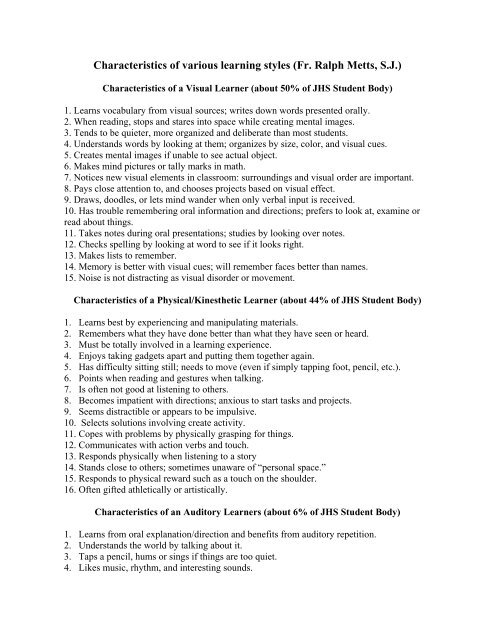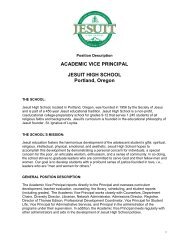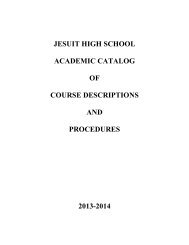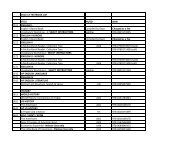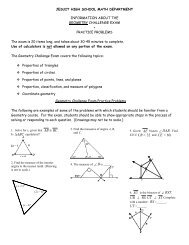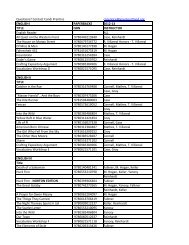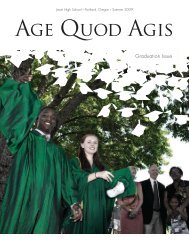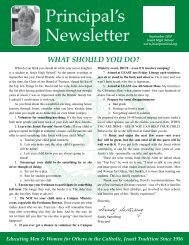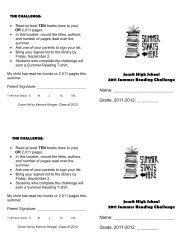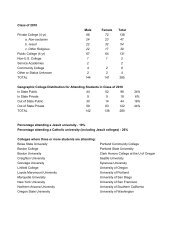Characteristics of various learning styles (Fr. Ralph Metts, S.J.)
Characteristics of various learning styles (Fr. Ralph Metts, S.J.)
Characteristics of various learning styles (Fr. Ralph Metts, S.J.)
You also want an ePaper? Increase the reach of your titles
YUMPU automatically turns print PDFs into web optimized ePapers that Google loves.
<strong>Characteristics</strong> <strong>of</strong> <strong>various</strong> <strong>learning</strong> <strong>styles</strong> (<strong>Fr</strong>. <strong>Ralph</strong> <strong>Metts</strong>, S.J.)<br />
<strong>Characteristics</strong> <strong>of</strong> a Visual Learner (about 50% <strong>of</strong> JHS Student Body)<br />
1. Learns vocabulary from visual sources; writes down words presented orally.<br />
2. When reading, stops and stares into space while creating mental images.<br />
3. Tends to be quieter, more organized and deliberate than most students.<br />
4. Understands words by looking at them; organizes by size, color, and visual cues.<br />
5. Creates mental images if unable to see actual object.<br />
6. Makes mind pictures or tally marks in math.<br />
7. Notices new visual elements in classroom: surroundings and visual order are important.<br />
8. Pays close attention to, and chooses projects based on visual effect.<br />
9. Draws, doodles, or lets mind wander when only verbal input is received.<br />
10. Has trouble remembering oral information and directions; prefers to look at, examine or<br />
read about things.<br />
11. Takes notes during oral presentations; studies by looking over notes.<br />
12. Checks spelling by looking at word to see if it looks right.<br />
13. Makes lists to remember.<br />
14. Memory is better with visual cues; will remember faces better than names.<br />
15. Noise is not distracting as visual disorder or movement.<br />
<strong>Characteristics</strong> <strong>of</strong> a Physical/Kinesthetic Learner (about 44% <strong>of</strong> JHS Student Body)<br />
1. Learns best by experiencing and manipulating materials.<br />
2. Remembers what they have done better than what they have seen or heard.<br />
3. Must be totally involved in a <strong>learning</strong> experience.<br />
4. Enjoys taking gadgets apart and putting them together again.<br />
5. Has difficulty sitting still; needs to move (even if simply tapping foot, pencil, etc.).<br />
6. Points when reading and gestures when talking.<br />
7. Is <strong>of</strong>ten not good at listening to others.<br />
8. Becomes impatient with directions; anxious to start tasks and projects.<br />
9. Seems distractible or appears to be impulsive.<br />
10. Selects solutions involving create activity.<br />
11. Copes with problems by physically grasping for things.<br />
12. Communicates with action verbs and touch.<br />
13. Responds physically when listening to a story<br />
14. Stands close to others; sometimes unaware <strong>of</strong> “personal space.”<br />
15. Responds to physical reward such as a touch on the shoulder.<br />
16. Often gifted athletically or artistically.<br />
<strong>Characteristics</strong> <strong>of</strong> an Auditory Learners (about 6% <strong>of</strong> JHS Student Body)<br />
1. Learns from oral explanation/direction and benefits from auditory repetition.<br />
2. Understands the world by talking about it.<br />
3. Taps a pencil, hums or sings if things are too quiet.<br />
4. Likes music, rhythm, and interesting sounds.
5. Enjoys hearing himself/herself and others talk.<br />
6. Likes to recite information or read orally.<br />
7. When reading silently, moves lips, says words to self, and <strong>of</strong>ten reads slowly.<br />
8. Good at remembering and telling jokes.<br />
9. Would rather listen to a story; enjoys talking about stories.<br />
10. Easily distracted by sounds and noises.<br />
11. Spoken language is easy, written expression more difficult.<br />
12. Counts to self; talks to self when solving problems.<br />
13. Discusses problems and talks through the steps when solving a difficult problem.<br />
14. Demonstrates good oral spelling.<br />
15. Can solve math problems in head.<br />
16. Plans for future by talking about it.<br />
17. Has trouble with maps, diagrams, and visuals.<br />
18. Learns by oral explanation.<br />
19. Studies by reading notes to friend; likes “talking through” information.<br />
20. Gives ten reasons for everything. Can be verbose.<br />
21. Can remember names better than faces.


